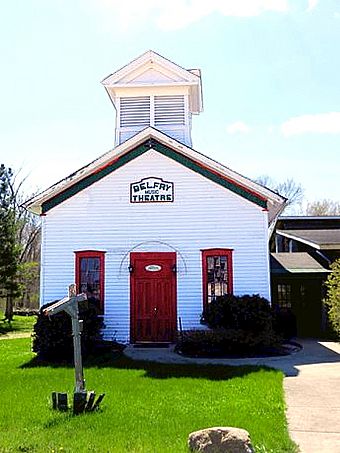Belfry Players facts for kids
|
Belfry Music Theatre
|
|

Belfry Music Theatre
|
|
| Former names | Belfry Players |
|---|---|
| Location | Highway 67 Delavan, Wisconsin |
| Coordinates | 42°35′49″N 88°32′29″W / 42.59708°N 88.54149°W |
| Owner | Transformative Arts |
| Operator | Transformative Arts |
| Type | Indoor |
| Seating type | Reserved |
| Capacity | 240 |
| Construction | |
| Built | 1888 |
| Reopened | 2016 |
The Belfry Music Theatre is a famous building in Delavan, Wisconsin. It used to be known as the Belfry Theater and The Belfry Players. This special place started as a church in 1888. Later, it became the very first summer stock theater in Wisconsin.
A summer stock theater is where actors perform plays during the summer. They often put on many different shows quickly. From 1935 to 1969, the Belfry was a busy theater. Many actors got their start here. Famous names like Paul Newman, Gary Burghoff, and Harrison Ford performed on its stage.
After 1969, the theater kept going for local shows. In 2016, the Belfry Music Theatre was updated. Now, it's a popular spot for music concerts and other events.
History of the Belfry Theater
The Belfry is located on Bailey Road in Delavan, Wisconsin. It used to be called Delap Corners. The theater started putting on shows in the early 1930s. It was a non-profit group that performed plays in the countryside.
The building itself was once a church. It was built in 1888. In the 1930s, it was changed to be a theater. The group called the Belfry Players first rented the building in 1934. They bought it in 1938. A large shed was added later. This shed was used to build and store the scenery for the plays. A nearby building, called Belfry House, was a place for the actors to live.
In the late 1960s, the theater faced a challenge. A highway project meant the building had to be moved. The Belfry building was saved, but the theater company had money problems. They stopped putting on shows between 1969 and 1976.
A director named Barry E. Silverman took over in 1976. He started shows again for three years. The theater closed after the 1979 season. Even after regular shows stopped, some performances happened into the 1990s. For example, Eddie Cash put on music tribute shows. In 2013, a company called Transformative Arts, Inc. bought the theater buildings.
Actors and Performances
For most of its history, the Belfry had a mix of local amateur actors and paid professional actors. They put on a series of six plays each summer. A new play would open every two weeks. This meant actors had to work very fast!
In the early days, actors who were paid also had to help build and paint the sets. The theater got money from ticket sales and from people who became members. Later, under new management in the 1970s, actors were paid more. This allowed them to focus only on acting.
Many well-known actors got their start at the Belfry. These include:
- Paul Newman (in 1949)
- Del Close (in 1953)
- Gary Burghoff (in 1962)
- Harrison Ford (in 1964)
The fast pace at the Belfry was hard work. Actors would rehearse and build sets all day. Then they would perform almost every night. Some actors found it tiring but also great training. Paul Newman once said it was hard to prepare in such a short time. He felt actors mostly learned to repeat their habits. However, others thought the experience was valuable. It taught young actors how to make their characters clear to the audience.
Types of Shows
When the Belfry's bell worked, it would ring to let everyone know the show was about to start.
In the very first season in 1934, two plays were performed. They were called The Youngest and Laff That Off. Over the next few summers, the number of shows grew. In 1938, they put on eight productions. By 1940, they usually did six shows per season. This continued through the early 1960s.
Most of the plays were light and fun. They were often comedies by writers like Noël Coward and George S. Kaufman. There were also light mysteries by Agatha Christie. In the 1950s and 1960s, the Belfry sometimes put on more serious plays. These included works by Arthur Miller and Tennessee Williams.
In the early 1960s, musicals were added to the schedule. These included Babes in Arms and The Boy Friend. In the 1970s, even more musicals were performed. For example, in 1978, they put on three musicals: The Roar of the Greasepaint, the Smell of the Crowd, Side by Side by Sondheim, and Oklahoma!.
Today, the sign outside the building says "Belfry Music Theatre." This shows its current focus on music.
Images for kids


